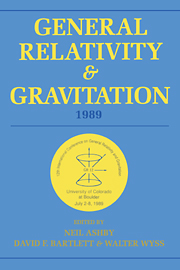 General Relativity and Gravitation, 1989
General Relativity and Gravitation, 1989 Published online by Cambridge University Press: 05 March 2012
Introduction
After 20 years of careful and innovative experimenting most of the researchers in the field of gravitational wave detection believe that success is on the horizon. Theoretical predictions of source strengths and source types have been steadily evolving and it is now clear that we should be aiming to build gravitational wave detectors which have strain sensitivities of ∼ 10-22 over kilohertz bandwidths. Such sensitivity should allow the detection of signals from, for example, supernova events at distances out to the Virgo cluster, coalescing compact binary systems and continuous and stochastic background sources.
One of the most promising ways of achieving the required sensitivity and bandwidth is to use laser interferometry between freely suspended test masses placed several kilometers apart, and the majority of contributions to the workshop on laser interferometer gravitational wave detectors were related to the large laser interferometer projects currently well advanced in planning. These instruments rely on searching for changes in the relative length of two paths, usually at right angles to each other, and formed between the test masses suspended as pendulums.
As will be mentioned again later, a number of interferometers are required around the world to obtain useful astrophysical information from the strength, polarization and timing of signals detected, and currently the belief is that at least three separate detector systems at different sites are necessary.
To save this book to your Kindle, first ensure [email protected] is added to your Approved Personal Document E-mail List under your Personal Document Settings on the Manage Your Content and Devices page of your Amazon account. Then enter the ‘name’ part of your Kindle email address below. Find out more about saving to your Kindle.
Note you can select to save to either the @free.kindle.com or @kindle.com variations. ‘@free.kindle.com’ emails are free but can only be saved to your device when it is connected to wi-fi. ‘@kindle.com’ emails can be delivered even when you are not connected to wi-fi, but note that service fees apply.
Find out more about the Kindle Personal Document Service.
To save content items to your account, please confirm that you agree to abide by our usage policies. If this is the first time you use this feature, you will be asked to authorise Cambridge Core to connect with your account. Find out more about saving content to Dropbox.
To save content items to your account, please confirm that you agree to abide by our usage policies. If this is the first time you use this feature, you will be asked to authorise Cambridge Core to connect with your account. Find out more about saving content to Google Drive.